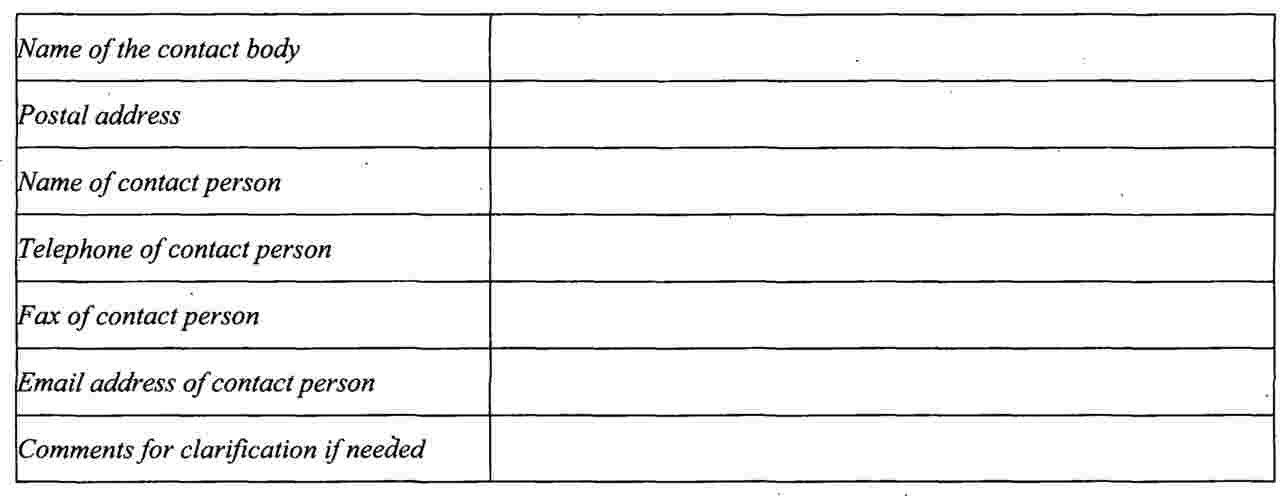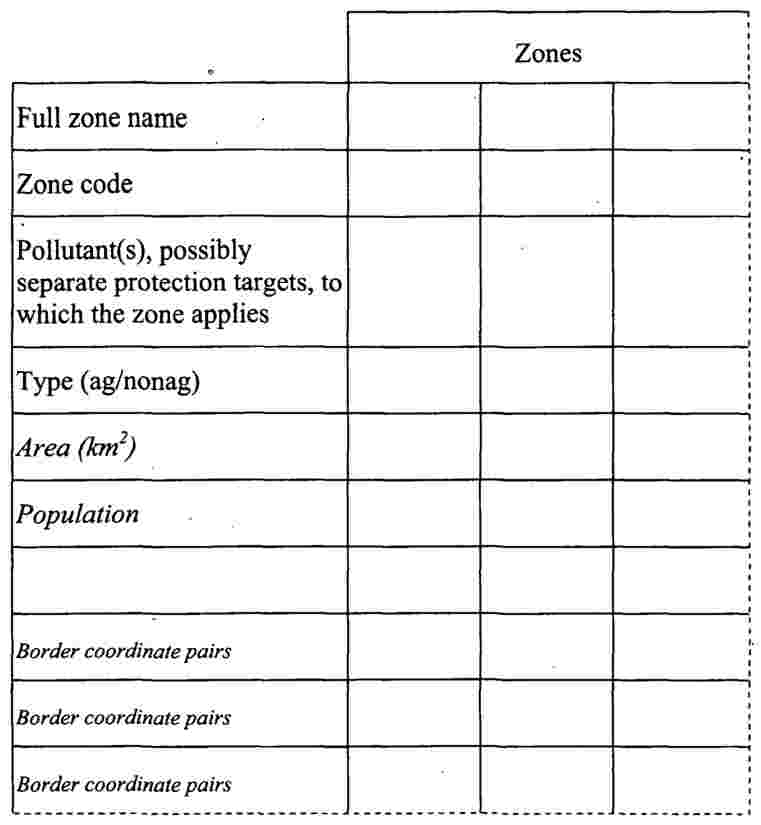2004/461/EC:Commission Decision of 29 April 2004 laying down a questionnaire to be used for annual reporting on ambient air quality assessment under Council Directives 96/62/EC and 1999/30/EC and under Directives 2000/69/EC and 2002/3/EC of the European Parliament and of the Council [notified under document number C(2004) 1714] (Text with EEA relevance)
| Published date | 30 April 2004 |
| Subject Matter | Environment |
| Official Gazette Publication | Official Journal of the European Union, L 156, 30 April 2004 |
| 30.4.2004 | EN | Official Journal of the European Communities | L 156/78 |
COMMISSION DECISION
of 29 April 2004
laying down a questionnaire to be used for annual reporting on ambient air quality assessment under Council Directives 96/62/EC and 1999/30/EC and under Directives 2000/69/EC and 2002/3/EC of the European Parliament and of the Council
(notified under document number C(2004) 1714)
(Text with EEA relevance)
(2004/461/EC)
THE COMMISSION OF THE EUROPEAN COMMUNITIES,
Having regard to the Treaty establishing the European Community,
Having regard to Council Directive 96/62/EC of 27 September 1996 on ambient air quality assessment and management (1), and in particular Article 12(1) thereof,
Whereas:
| (1) | Directive 96/62/EC establishes the framework for assessment and management of ambient air quality and provides that detailed arrangements are to be laid down for the reporting of information on air quality. |
| (2) | Council Directive 1999/30/EC of 22 April 1999 relating to limit values for sulphur dioxide, nitrogen dioxide and oxides of nitrogen, particulate matter and lead in ambient air (2) lays down limit values to be met on a certain target date. |
| (3) | Commission Decision 2001/839/EC laying down a questionnaire to be used for annual reporting on ambient air quality assessment under Directives 96/62/EC and 1999/30/EC (3) provided a model on the basis of which Member States were to provide the information on air quality required under those Directives. |
| (4) | Directive 2000/69/EC of the European Parliament and of the Council of 16 April 2000 relating to limit values for benzene and carbon monoxide in ambient air (4) lays down limit values to be met on a certain target date. Directive 2002/3/EC of the European Parliament and of the Council of 12 February 2002 relating to ozone in ambient air (5) lays down target values, long-term objectives, information and alert thresholds which create certain obligations. Regular reporting by Member States is an integral element of those Directives, read in conjunction with Directive 96/62/EC and indispensable for checking compliance with those obligations. |
| (5) | Moreover, a number of items set out in Article 11 of Directive 96/62/EC with regard to the pollutants covered by Directives 1999/30/EC, 2002/69/EC and 2002/3/EC must be reported on an annual basis. |
| (6) | According to Directive 1999/30/EC, provisions on reporting under Council Directive 80/779/EEC on air quality limit values and guide values for sulphur dioxide and suspended particulates (6),Council Directive 82/884/EEC of 3 December 1982 on a limit value for lead in the air (7) and Council Directive 85/203/EEC of 7 March 1982 on air quality standards for nitrogen dioxide (8) are repealed with effect from 19 July 2001, although the limit values under these Directives remain in force until 2005 for Directives 80/779/EEC and 82/884/EEC, and 2010 for Directive 85/203/EEC and reporting on exceedences of these limit values continues according to Article 9(6) of Directive 1999/30/EC. |
| (7) | In order to ensure that the required information is supplied in the correct format, Member States should be required to submit it on the basis of a standardised questionnaire. |
| (8) | The questionnaire laid down by Decision 2001/839/EC should be extended to cover also the annual reporting obligations resulting from Directives 2000/69/EC and 2002/3/EC, while at the same time introducing some amendments related to Directive 1999/30/EC, which are made for clarification and in order to ensure a better assessment of the reports. |
| (9) | Decision 2001/839/EC should be replaced in the interests of clarity. |
| (10) | The measures provided for in this Decision are in accordance with the opinion of the Committee instituted by Article 12 (2) of Directive 96/62/EC, |
HAS ADOPTED THIS DECISION:
Article 1
Member States shall use the questionnaire set out in the Annex as a basis for forwarding the information to be provided on an annual basis in accordance with Articles 11(1) and 12(1) of Directive 96l62fEC and the following provisions:
| — | Articles 3(1), (3) and (4), 4(1), 5(1), (2), (4) and (5), 6, 7(1), (2) and (3), and 9(6) of Directive 1999/30/EC, |
| — | Articles 3(1), 4, and 5(1), (2), (3) and (5) of Directive 2000/69/EC and |
| — | Articles 3(1) and (2), 4(1) and (2), 5, 9 (1) and (3), and 10 (1)(a) and (2)(b) of Directive 2002/3/EC. |
Article 2
Decision 2001/839/EC is hereby repealed.
Article 3
This Decision is addressed to the Member States.
Done at Brussels, 29 April 2004.
For the Commission
Margot WALLSTRÖM
Member of the Commission
(1) OJ L 296, 21.11.1996, p. 55. Directive as amended by Regulation (EC) No 1882/2003 (OJ L 284, 31.10.2003, p. 1).
(2) OJ L 163, 29.6.1999, p.41. Directive as amended by Decision 2001/744/EC (OJ L 278, 23.10.2001, p. 35).
(3) OJ L 319, 4.12.2001, p.45.
(4) OJ L 313, 13.12.2000, p.12.
(5) OJ L 67, 9.3.2002, p. 14.
(6) OJ L 229, 30.8.1980, p.30.
(7) OJ L378, 31.12.1982, p.15.
(8) OJ L 87, 27.3.1985, p.1.
ANNEX
Reporting Questionnaire
on
Council Directive 96/62/EC on ambient air quality assessment and management and Council Directive 1999/30/EC relating to limit values for sulphur dioxide, nitrogen dioxide and oxides of nitrogen, particulate matter and lead in ambient air as well as Directives 2000/69/EC relating to limit values for benzene and carbon monoxide in ambient air and 2002/3/EC relating to ozone in ambient air of the European Parliament and the Council
MEMBER STATE: ...
CONTACT ADDRESS: ...
REFERENCE YEAR: ...
COMPILATION DATE: ...
The following forms distinguish between items that are legally required to report and items that are voluntary to report for the Member State. Voluntary items are printed in italic.
Many of the forms below contain and indefinite number of rows or columns to be filled in. In the form description, the number of empty rows or columns to be filled in is then limited to three and a dashed borderline indicates that the form should be extended as needed.
In addition to the forms, which are to be filled in by the Member State, some tables are also provided. The tables provide information such as fixed codes that are not to be changed by the Member State.
List of forms
| Form 1 | Contact body and address |
| Form 2 | Delimitation of zones and agglomerations |
| Form 3 | Stations and measuring methods used for assessment under 1999/30/EC and 2000/69/EC |
| Form 4 | Stations used for assessment of ozone, including nitrogen dioxide and nitrogen oxides in relation to ozone |
| Form 5 | Stations and measuring methods used for the assessment of recommended volatile organic compounds |
| Form 6 | Stations and measurement methods used for the assessment of other ozone precursor substances |
| Form 7 | Methods used to sample and measure PM10 and PM2,5 and ozone precursor substances: optional additional codes to be defined by the Member State |
| Form 8 | List of zones and agglomerations where levels exceed or do not exceed limit values or limit values plus margin of tolerance |
| Form 9 | List of zones and agglomerations where levels exceed or do not exceed target values or long term objectives for ozone |
| Form 10 | List of zones and agglomerations where levels exceed or do not exceed upper assessment thresholds or lower assessment thresholds, including information on the application of supplementary assessment methods |
| Form 11 | Individual exceedences of limit values and limit values plus the margin of tolerance |
| Form 12 | Reasons for individual exceedences: optional additional codes to be defined by the Member State |
| Form 13 | Individual exceedences of ozone thresholds |
| Form 14 | Exceedence of ozone target values |
| Form 15 | Annual statistics of ozone |
| Form 16 | Annual average concentrations of ozone precursor substances |
| Form 17 | Monitoring data on 10 minutes mean SO2 levels |
| Form 18 | Monitoring data on 24hr mean PM2,5 levels |
| Form 19 | Tabular results of and methods used for supplementary assessment |
| Form 20 | List of references to supplementary assessment methods referred to in Form 19 |
| Form 21 | Exceedence of limit values for SO2 due to natural sources |
| Form 22 | Natural SO2 sources: optional additional codes to be defined by Member State |
| Form 23 | Exceedence of limit values of PM10 due to natural events |
| Form 24 | Exceedence of limit values of PM10 due to winter sanding |
| Form 25 | Consultations on transboundary pollution |
| Form 26 | Exceedences of limit values laid down in Directives 80/779/EEC, 82/884/EEC and 85/203/EEC |
| Form 27 | Reasons for exceedences of limit values laid down in Directives 80/779/EEC, 82/884/EEC and 85/203/EEC: optional additional codes to be defined by the Member State |
List of tables
| Table 1 | Methods used to sample and measure PM10 and PM2,5 and ozone precursor substances: standard codes |
| Table 2 | Reasons for individual exceedences: standard codes |
| Table 3 | Statistical parameters to be used in concentration maps |
| Table 4 | Natural SO2 sources: standard codes |
| Table 5 | Natural events causing limit value exceedences for PM10: standard codes |
Form 1 Contact body and address

Note to Form 1:
The Member State is asked to fill in the contact body, and if possible, the contact person at national level, that the Commission may approach on details regarding this questionnaire if needed.
Form 2 Delimitation of zones and agglomerations (96/62/EC Articles 5 and ll(1b))

Notes to Form 2:
| (1) | The Member State should give not only the zone name, but also a unique zone code. |
| (2) | The Member State should indicate the pollutant(s) to which the zone applies using the codes: ‘S’ for |
To continue reading
Request your trial
